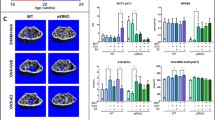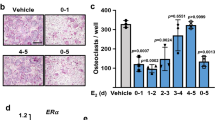Abstract
In this paper we investigated how the increase of human estrogen receptor alfa (ERα) gene expression may affect breast, osteoblast and osteoclast cells. Increase of ERα expression was obtained by interfering with the activity of a negative transcription factor and by removing it with a short and powerful decoy oligonucleotide (RA4-3′) mimicking a region of distal promoter C of ERα gene. We provide evidence that this decoy was able to induce apoptosis in osteoclasts, but not in osteoblasts and in breast cancer cells, in an estrogen dependent manner. This effect was associated with increase of the levels of Caspase 3 and Fas receptor. Since ERα is important in the transcription of different genes and is involved in several pathological processes, including neoplastic and osteopenic diseases, our findings may be of relevance for a possible new therapeutical approach of such diseases.
Similar content being viewed by others
References
Song RXD, Santen RJ. Apoptotic action of estrogen. Apoptosis 2003; 8: 55–60.
Nilsson S, Makela S, Treuter E, et al. Mechanisms of estrogen action. Physiol Rev 2001; 81: 1535–1565.
Lee YJ, Renaud RA, Friedrich TC, Gorski J. Estrogen causes cell death of estrogen receptor stably transfected cells via apoptosis. J Steroid Biochem & Mol Biol 1998; 67: 327–332.
Vaananen H.K. Mechanism of bone turnover. Ann Med 1993; 25: 353–359.
Riggs BL, Khosla S, Melton LJ III. Sex steroids and the construction and conservation of the adult skeleton. Endocr Rev 2002; 23: 279–302.
Rodan GA, Martin TJ. Therapeutic approaches to bone diseases. Science 2000; 289: 1508–1514.
Manolagas SC, Kousteni S, Jilka RL. Sex steroids and bone. Recent Prog Horm Res 2002; 57: 385–409.
Schulte CMS, Beelen DW. Bone loss following hematopoietic stem cell transplantation: A long-term follow-up. Blood 2004; 103: 3635–3643.
Riggs BL. The mechanisms of estrogen regulation of bone resorption. Journal of Clinical Investigation 2000; 106: 1203–1204.
Roodman GD. Advances in bone biology: The osteoclasts. Endocr Rev 1996; 17: 308–332.
Yang X, Karsenty G. Transcription factors in bone: Developmental and pathological aspects. Trends in Molecular Medicine 2002; 8: 340–345.
Walsh NC, Gravallese EM. Bone loss in inflammatory arthritis: Mechanisms and treatment strategies. Curr Opin Rheumatol 2004; 16: 419–427.
Moreno JL, Kaczmarek M, Keegan AD, Tondravi M. IL-4 suppresses osteoclast development and mature osteoclast function by a STAT6-dependent mechanism: Irreversible inhibition of the differentiation program activated by RANKL. Blood 2003; 102: 1078–1086.
Kameda T, Mano H, Yuasa T, et al. Estrogen inhibits bone resorption by directly inducing apoptosis of the bone-resorbing osteoclasts. Journal of Experimental Medicine 1997; 186: 489–495.
Piva R, Gambari R. Transcription factor decoy (TFD) in breast cancer research and treatment. Technology in Cancer Research Treatment 2002; 1: 405–416.
Morishita R. Perspective in progress of cardiovascular gene therapy. Journal of Pharmacological Science 2004; 95: 1–8.
Morishita R, Sugimoto T, Aoki M, et al. In vivo transfection of cis element “decoy” against nuclear factor-kappaB binding site prevents myocardial infarction. Nature Medicine 1997; 3: 894–899.
Tomita N, Kim JY, Gibbons GH, et al. Gene therapy with an E2F transcription factor decoy inhibits cell cycle progression in rat anti-Thy 1 glomerulonephritis. International Journal of Molecular Medicine 2004; 13: 629–636.
Gewirtz AM, Sokol DL, Ratajczak MZ. Nucleic acid therapeutics: State of the art and future prospects. Blood1998; 92: 712–736.
Penolazzi L, Lambertini E, Aguiari G, del Senno L, Piva R. Cis element “decoy” against upstream promoter of the human estrogen receptor gene. Biochim Biophys Acta 2000; 1492: 560–567.
Lambertini E, Penolazzi L, Aguiari G, et al. Osteoblastic differentiation induced by transcription factor decoy against estrogen receptor alpha gene. Biochemical & Biophysical Research Communication 2002; 292: 761–770.
Kos M, Reid G, Denger S, Gannon F. Minireview: Genomic organization of the human ERalpha gene promoter region. Molecular Endocrinology 2001; 15: 2057–2063.
Yoshida T, Eguchi H, Nakachi K, et al. Distinct mechanisms of loss of estrogen receptor gene expression in human breast cancer: Methylation of the gene and alteration of trans-acting factors. Carcinogenesis 2000; 21: 2193–2201.
Maeda K, Tsuda H, Hashiguchi Y, et al. Relationship between p53 pathway and estrogen receptor status in endometrioid-type endometrial cancer. Human Pathology 2002; 33: 386–391.
Thomas RJ, Guise TA, Yin JJ, et al. Breast cancer cells interact with osteoblasts to support osteoclast formation. Endocrinology 1999; 140: 4451–4458.
Winding B, Misander H., Hoegh-Andersen P, Brunner N, Foged NT. Estradiol enhances osteolytic lesions in mice inoculated with human estrogen receptor-negative MDA-231 breast cancer cells in vivo. Breast Cancer Research & Treatment 2003; 78: 205–216.
Osipo C, Gajdos C, Liu H, Chen B, Jordan VC. Paradoxical Action of Fulvestrant in Estradiol-Induced Regression of Tamoxifen-Stimulated Breast Cancer. J Natl Cancer Inst 2003; 95: 1597–1608.
Ashkenazi A, Dixit VM. Death receptors: Signaling and modulation. Science 1998; 281: 1305–1308.
Matsuzaki K, Katayama K, Takahashi Y, et al. Human osteoclast-like cells are formed from peripheral blood mononuclear cells in a coculture with SaOS-2 cells transfected with the parathyroid hormone (PTH)/PTH-related protein receptor gene. Endocrinology 1999; 140: 925–932.
Maurizi M, Binaglia L, Donti E, Ottaviani F, Paludetti G, Venti Donti G. Morphological and functional characteristics of human temporal-bone cell cultures. Cell & Tissue Research 1983; 229: 505–513.
Penolazzi L, Lambertini E, Borgatti M, et al. Decoy oligodeoxynucleotides targeting NF-kappaB transcription factors: Induction of apoptosis in human primary osteoclasts. Biochemical Pharmacology 2003; 66: 1189–1198.
Villanova I, Townsed PA, Uhlmann E, et al. Oligodeoxynucleotide targeted to the alphav gene inhibits alphav integrin synthesis, impairs osteoclast function, and activates intracellular signals to apoptosis. Journal of Bone & Mineral Research 1999; 14: 1867–1879.
Denizot F, Lang RJ. Rapid colorimetric assay for cell growth and survival. Modifications to the tetrazolium dye procedure giving improved sensitivity and reliability. Immunol Meth 1986; 22: 271–277.
Fibach E, Bianchi N, Borgatti M, Prus E, Gambari R. Mithramycin induces fetal hemoglobin production in normal and thalassemic human erythroid precursor cells. Blood 2003; 102: 1276–1281.
Dignam JD, Lebovitz RM, Roeder RG. Accurate transcription initiation by RNA polymerase II in a soluble extract from isolated mammalian nuclei. Nucleic Acids Research 1983; 11: 1475–1489.
Hirotani H, Tuohy NA, Woo JT, Stern PH, Clipstone NA. The calcineurin/nuclear factor of activated T cells signaling pathway regulates osteoclastogenesis in RAW264.7 cells. Journal of Biological Chemistry 2004; 279: 13984–13992.
Harada S, Sampath TK, Aubin JE, Rodan GA. Osteogenic protein-1 up-regulation of the collagen X promoter activity is mediated by a MEF-2-like sequence and requires an adjacent AP-1 sequence. Molecular Endocrinology 1997; 11: 1832–1845.
Fox SB, Brown P, Han C, et al. Expression of the forkhead transcription factor FOXP1 is associated with estrogen receptor alpha and improved survival in primary human breast carcinomas. Clinical Cancer Research 2004; 10: 3521–3527.
van Noort M, Clevers H. TCF transcription factors, mediators of Wnt-signaling in development and cancer. Dev Biol 2002; 244: 1–8.
Sharrocks AD. The ETS-domain transcription factor family. Nat Rev Mol Cell Biol 2001; 2: 827–837.
Sooy K, Demay MB. Transcriptional repression of the rat osteocalcin gene by deltaEF1. Endocrinology 2002; 143: 3370–3375.
Levenson AS, Jordan VC. Transfection of human estrogen receptor (ER) cDNA into ER-negative mammalian cell lines. J Steroid Biochem Mol Biol 1994; 51: 229–239.
Wu X, Pan G, McKenna MA, Zayzafoon M, Xiong WC, McDonald JM. RANKL regulates Fas expression and Fas-mediated apoptosis in osteoclasts. J Bone Miner Res 2005; 20: 107–116.
Song RXD, Mor G, Naftolin F, McPherson RA, Song J, Zhang Z, Yue W, Wang JP, Santen RJ. Effect of Long-Term Estrogen Deprivation on Apoptotic Responses of Breast Cancer Cells to 17-β Estradiol. J Natl Cancer Inst 2001; 93: 1714–1723.
Igarashi K, Hirotani H, Woo JT, Stern PH. Cyclosporine A and FK506 induce osteoclast apoptosis in mouse bone marrow cell cultures. Bone 2004; 35: 47–56.
Sudhoff H, Jung JY, Ebmeyer J, Faddis BT, Hildmann H, Chole RA. Zoledronic acid inhibits osteoclastogenesis in vitro and in a mouse model of inflammatory osteolysis. Ann Otol Rhinol Laryngol 2003; 112: 780–786.
Rogers MJ. New insights into the molecular mechanisms of action of bisphosphonates. Curr Pharm Des 2003; 9: 2643–2658.
Hogan PG, Chen L, Nardone J, Rao A. Transcriptional regulation by calcium, calcineurin, and NFAT. Genes and Development 2003; 17: 2205–2232.
Weinstein RS, Manolagas SC. Apoptosis and osteoporosis. American Journal of Medicine 2000; 108: 153–164.
Delmas PD, Meunier PJ. The management of Paget’s disease of bone. New England Journal of Medicine 1997; 336: 558–566.
Hurtado J, Esbrit P. Treatment of malignant hypercalcaemia. Expert Opin Pharmacother 2002; 3: 521–527.
Voskaridou E, Kyrtsonis MC, Terpos E, et al. Bone resorption is increased in young adults with thalassaemia major. British Journal of Haematology 2001; 112: 36–41.
Author information
Authors and Affiliations
Corresponding author
Rights and permissions
About this article
Cite this article
Piva, R., Penolazzi, L., Lambertini, E. et al. Induction of apoptosis of human primary osteoclasts treated with a transcription factor decoy mimicking a promoter region of estrogen receptor α. Apoptosis 10, 1079–1094 (2005). https://doi.org/10.1007/s10495-005-0618-8
Issue Date:
DOI: https://doi.org/10.1007/s10495-005-0618-8




